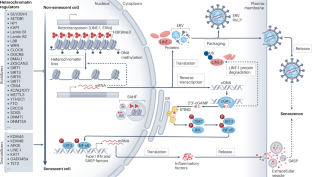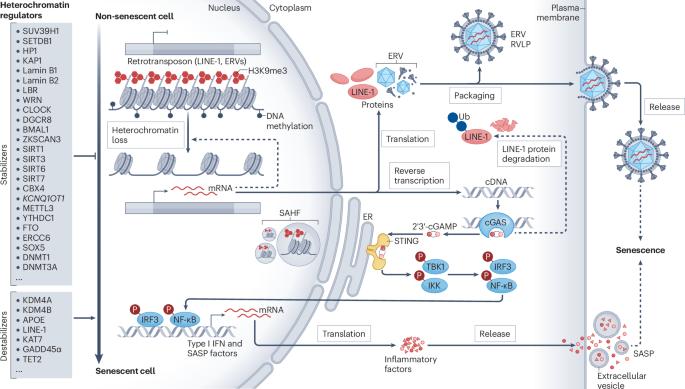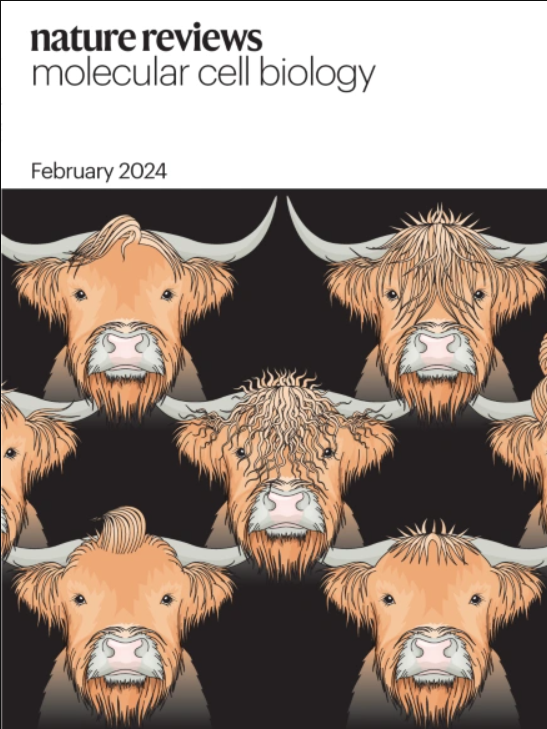染色质和基因组不稳定性在细胞衰老中的作用及其与衰老和相关疾病的关系
IF 90.2
1区 生物学
Q1 CELL BIOLOGY
引用次数: 0
摘要
衰老是一个复杂的生物过程,在这个过程中,生理机能的逐渐衰退增加了对神经退行性疾病和癌症等疾病的易感性。细胞衰老是一种不可逆的细胞生长停滞状态,伴随着功能退化,已成为老化的关键驱动因素。在这篇综述中,我们将讨论异染色质丢失、端粒损耗和 DNA 损伤如何通过引发基因组不稳定性、先天免疫和炎症而导致细胞衰老、老化和与年龄相关的疾病。我们还讨论了新出现的治疗策略如何能够恢复异染色质的稳定性、维持端粒的完整性和提高DNA修复能力,从而对抗细胞衰老和与衰老相关的病症。最后,我们概述了当前的研究挑战和未来的研究方向,旨在更好地理解和延缓衰老。本文章由计算机程序翻译,如有差异,请以英文原文为准。


Roles of chromatin and genome instability in cellular senescence and their relevance to ageing and related diseases
Ageing is a complex biological process in which a gradual decline in physiological fitness increases susceptibility to diseases such as neurodegenerative disorders and cancer. Cellular senescence, a state of irreversible cell-growth arrest accompanied by functional deterioration, has emerged as a pivotal driver of ageing. In this Review, we discuss how heterochromatin loss, telomere attrition and DNA damage contribute to cellular senescence, ageing and age-related diseases by eliciting genome instability, innate immunity and inflammation. We also discuss how emerging therapeutic strategies could restore heterochromatin stability, maintain telomere integrity and boost the DNA repair capacity, and thus counteract cellular senescence and ageing-associated pathologies. Finally, we outline current research challenges and future directions aimed at better comprehending and delaying ageing. Heterochromatin loss, telomere attrition and DNA damage induce cellular senescence by eliciting genome instability and innate immunity responses, thereby promoting ageing and age-related diseases. This Review discusses the underlying mechanisms of these processes and emerging cell-senescence therapeutics that target them.
求助全文
通过发布文献求助,成功后即可免费获取论文全文。
去求助
来源期刊
CiteScore
173.60
自引率
0.50%
发文量
118
审稿时长
6-12 weeks
期刊介绍:
Nature Reviews Molecular Cell Biology is a prestigious journal that aims to be the primary source of reviews and commentaries for the scientific communities it serves. The journal strives to publish articles that are authoritative, accessible, and enriched with easily understandable figures, tables, and other display items. The goal is to provide an unparalleled service to authors, referees, and readers, and the journal works diligently to maximize the usefulness and impact of each article. Nature Reviews Molecular Cell Biology publishes a variety of article types, including Reviews, Perspectives, Comments, and Research Highlights, all of which are relevant to molecular and cell biologists. The journal's broad scope ensures that the articles it publishes reach the widest possible audience.

 求助内容:
求助内容: 应助结果提醒方式:
应助结果提醒方式:


